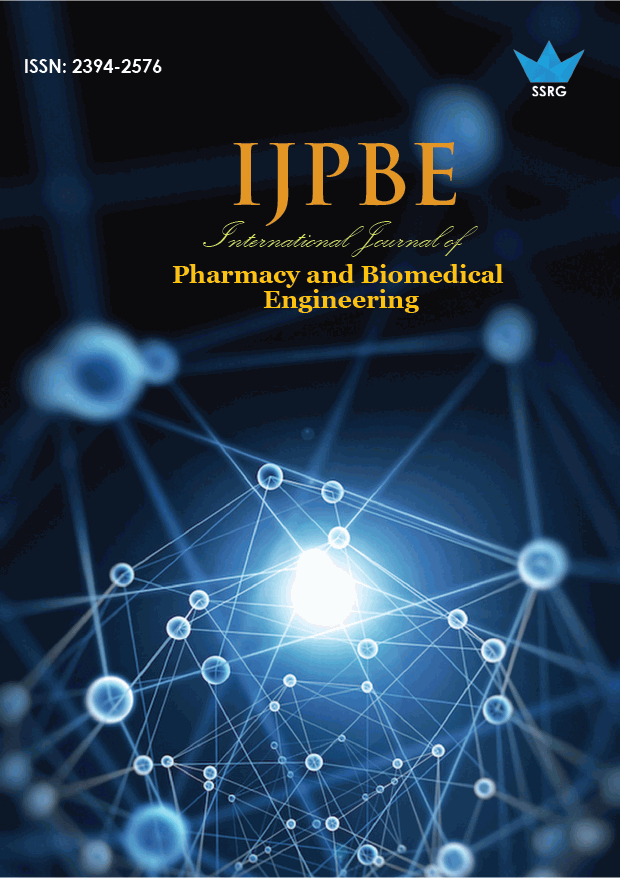Advanced brain injury Neuroprotection therapy

| International Journal of Pharmacy and Biomedical Engineering |
| © 2016 by SSRG - IJPBE Journal |
| Volume 3 Issue 2 |
| Year of Publication : 2016 |
| Authors : R.T.Sathik and K.Thanish |
How to Cite?
R.T.Sathik and K.Thanish, "Advanced brain injury Neuroprotection therapy," SSRG International Journal of Pharmacy and Biomedical Engineering, vol. 3, no. 2, pp. 1-3, 2016. Crossref, https://doi.org/10.14445/23942576/IJPBE-V3I2P101
Abstract:
The head injury typically talks about to TBI but is a larger category because it can include injury to assemblies other than the intelligence, such as the scalp and skull. Traumatic brain injury (TBI) disturbs a rising portion of the people and endures to take national attention with early payment in imaging equipment and in debt of long-term effects. TBI is the most important cause of death and failure to wide-reaching, specifically in teenagers and undeveloped adults. Males withstand traumatic brain injuries in additional habitually than do females. Though, there is great variance in TBI handling procedures due to injury inconsistency and absence of both automatous considerate and robust treatment references. In Recent years proposes three different handling methods, all which key purpose at cheering neuroprotection after that TBI, show possibilities: instantaneous hypothermia, hyperbaric oxygen, and progesterone enhancement. The investigation is provocative at times, yet there are profuse openings to develop the knowledge behind schedule hypothermia and hyperbaric oxygen therapy which would confidently aid in making straight the current data. Additionally, while progesterone has already been packaged in nanoparticle form, it may benefit from continued formulation and management investigation: the treatments and the opportunities for development are going through in the present paper.
Keywords:
hyperbaric oxygen, neuroprotection, progesterone enhancement, Traumatic brain.
References:
[1] Xu L, Yenari MA, Steinberg GK, Giffard RG. “Mild hypothermia reduces apoptosis of mouse neurons in vitro early in the cascade”. J Cereb Blood Flow Metab. 2002;22(1):21–8.
[2] Diller KR, Zhu L. “Hypothermia therapy for brain injury”. Annu Rev Biomed Eng. 2009;11:135–62.
[3] Thampatty BP, Klamerus MM, Oberly PJ, et al. “hypothermia decreases cerebrospinal fluid asymmetric dimethylarginine levels in children with traumatic brain injury”. PediatrCrit Care Med. 2013;14(4):403–12.
[4] Urbano LA, Oddo M. “Therapeutic hypothermia for traumatic brain injury”. CurrNeurolNeurosci Rep. 2012;12(5):580–91.
[5] Shiozaki T, Sugimoto H, Taneda M, et al. “Effect of mild hypothermia on uncontrollable intracranial hypertension after severe head injury.” J Neurosurg. 1993;79(3):363–8.
[6] Brain Trauma Foundation. “Guidelines for the Management of Severe Traumatic Brain Injury”. 3rd ed. New York, NY. Mary Ann Liebert, Inc. Publishers. 2007.
[7] Roberts I, Yates D, Sandercock P, et al. “Effect of intravenous corticosteroids on death within 14 days in 10008 adults with clinically significant head injury (MRC CRASH trial): a randomized placebo-controlled trial”. Lancet. Oct 9–15, 2004;364(9442):1321–8.

 10.14445/23942576/IJPBE-V3I2P101
10.14445/23942576/IJPBE-V3I2P101